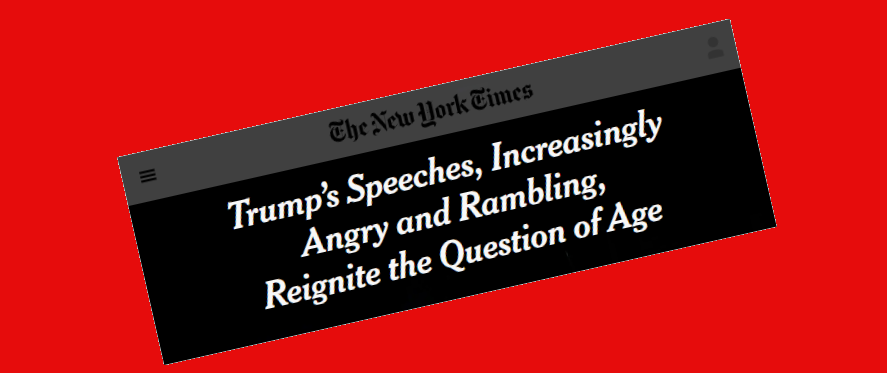Fitness
New York Times opens the media floodgates on stories about Trump’s mental unfitness | Press Watch

The New York Times has finally weighed in on the subject of Donald Trump’s mental unfitness. On Sunday, Peter Baker and Dylan Freedman described Trump’s obvious problems at great length.
It marked a red-letter day for journalism.
The New York Times is by far the most influential news organization in the media ecosphere. By publishing this story, it has created a permission structure for others to more directly address the issue of Trump’s mental fitness.
So let’s go! Start your engines! As I wrote, perhaps a bit prematurely a few weeks ago, Trump’s mental capacity is now topic one.
And what’s needed is not just one front-page story, but some top-of-the-newscast stories as well.
Further, Trump’s lack of mental fitness needs to be reflected in the daily coverage from this point forward, as crucial context every time he is mentioned or quoted.
And this particular article needs to be followed up, with more interviews with members of both parties, and especially with more neurologists.
As Michael Tomasky wrote in The New Republic on Monday, Baker and Freedman’s piece “could stand as the single most important piece of journalism in this election” – particularly if “the Times keeps finding ways to raise this question, and … other mainstream outlets follow.”
Baker and Freedman were admirably direct about Trump, as far as they went:
He rambles, he repeats himself, he roams from thought to thought — some of them hard to understand, some of them unfinished, some of them factually fantastical. He voices outlandish claims that seem to be made up out of whole cloth. He digresses into bizarre tangents about golf, about sharks, about his own “beautiful” body.
And while “untethered to the truth” is a far cry from “lies constantly,” this paragraph was pretty strong stuff for the Times:
He has always been discursive and has often been untethered to truth, but with the passage of time his speeches have grown darker, harsher, longer, angrier, less focused, more profane and increasingly fixated on the past.
The heart of the story was a statistical analysis:
According to a computer analysis by The New York Times, Mr. Trump’s rally speeches now last an average of 82 minutes, compared with 45 minutes in 2016. Proportionately, he uses 13 percent more all-or-nothing terms like “always” and “never” than he did eight years ago, which some experts consider a sign of advancing age.
Similarly, he uses 32 percent more negative words than positive words now, compared with 21 percent in 2016, which can be another indicator of cognitive change. And he uses swearwords 69 percent more often than he did when he first ran, a trend that could reflect what experts call disinhibition. (A study by Stat, a health care news outlet, produced similar findings.)
The story’s biggest shortcoming was its avoidance of the term “dementia” and the short shrift it gave to experts in the field. For instance, the article only quoted one neurologist:
Experts said it was hard to judge whether the changes in Mr. Trump’s speaking style could indicate typical effects of age or some more significant condition. “That can change with normal aging,” said Dr. Bradford Dickerson, a neurologist at Harvard Medical School. “But if you see a change relative to a person’s base line in that type of speaking ability over the course of just a few years, I think it raises some real red flags.”
And the words “dementia” or “cognitive decline” — though hinted at — don’t appear at all.
By contrast, psychiatrist Richard Friedman wrote in the Atlantic last month that Trump displays “some striking, if familiar, patterns that are commonly seen among people in cognitive decline.”
And Justin Frank, a Washington psychoanalyst and author of “Trump on the Couch,” told me in an interview last month that he sees signs of dementia and that journalists should talk to more neurologists about it.
Another giant problem with the article was that it failed to use the word “lie” even once. And it failed to connect the dots between Trump’s “rambling” and how his constant lies are not random – they come straight from the authoritarian playbook, consistently intended to divide the nation and terrify voters into electing a strongman. (See Ruth Ben-Ghiat.)
It’s also worth noting that Baker snuck an astonishing revelation into his 19th paragraph:
Some of Mr. Trump’s cabinet secretaries had a running debate over whether the president was “crazy-crazy,” as one of them put it in an interview after leaving office, or merely someone who promoted “crazy ideas.” There were multiple conversations about whether the 25th Amendment disability clause should be invoked to remove him from office, although the idea never went far.
How long has Baker been sitting on this quote? And while there have been vague reports in the past about such conversations within the cabinet, they’ve been in the context of the Jan. 6 insurrection, not his mental health. That strikes me as newsworthy.
Nevertheless, this remains a landmark story. Peter Baker is the single political reporter who most defines the New York Times’s institutional voice. He is one of publisher A.G. Sulzberger’s favorites. And there’s no way he would go out on a limb to write something he suspected would anger his bosses, quite the contrary.
This, therefore, is a strong sign that the institutional voice is changing for the better.
Up until now, most major news outlets have engaged in “sanewashing,” which, as newsletter author Parker Molloy and others have described, is the journalistic practice of turning incoherent, angry rambling into something that sounds like conventional political discourse.
That’s done in the service of treating Trump like a normal candidate instead of calling out his dangerous, demented lunacy.
It’s long past time for that to end, as the New York Times has now made clear.
We’ll be watching.










